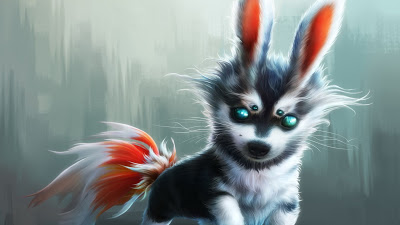Gibbat Dog
Frequency: Common only on Sahova.

Threat Level: Low to Medium (if in a pack)
Major Features: Four eyes, long ears, large tail.
Abilities: Excellent sight and hearing, able to see auras. Can jump far (10-14ft)
Most Common in: Forest of Thorns
The Birth of a Species:
In existence for almost three hundred years, the Gibbat has learnt to thrive on Sahova. Hectran Gibban, a wonderfully inspired alchemist and dog breeder blended many different species before he balanced his life’s work with this huge success. The Sahovan wizard took nearly a hundred years to perfect the minuscule breed. The completion of his work came with the Gibbat’s ability to reproduce on their own.
Shortly after successfully creating the first five Gibbat, Hectran found the group reproduced rather quickly. One of their sire species had been the hare and their productivity mimicked the hare’s speed. Soon he had more of the tiny things than he could handle in his lab. He was forced to release them into the training grounds of Sahova, though he kept two of the originals for study.
From there the Gibbat were victim to many of the island’s natural and unnatural predators. Though they are hunted, their fast reproduction saved them from extinction. The tiny canines began to evolve to use their unique skill set to survive and eventually thrive in the woodlands of Sahova. Today they are a common sight deep in the Forest of Thorns, but are not uncommon in more open areas during the day.
Appearance and Ability:
The Gibbat is a small canine with long, soft fur. About ten pounds at adulthood, the canine is far from massive. Hectran Gibban used mainly Zypherian sled dogs for his experiments, since they were so easy to train. The genetics of the dogs has a strong physical presence in the appearance of the Gibbat, though they are far smaller. Much of their mannerisms mimic the dogs as well, including their playful and compatible nature.
The Gibbat’s most peculiar and unique trait is without a doubt their eyes. The pearly blue orbs, two normal sized and two smaller, seem to give the Gibbat a very strong sense of sight. The small animal uses the large eyes to see normally, or almost perfectly at night. But the smaller eyes are there to be able to see the aura of living being. It took Gibban many more years to come to this conclusion, and he was unable to say for certain.
Along with amazing eyesight, the Gibbat’s hearing is quite remarkable. Their hare-like ears are designed to pick up on the sounds of the forest long before any predator comes close. They are, however, quite relaxed around humans and nuits, since their roots lie in a very domesticated dog. It is said a Gibbat can hear a leaf landing on the ground nearby.
Males have a fiery red tail that they wave and spread to attract a females. The female, however, has no red in her tail. Hers is shorter and the same black color as the rest of her fur.
The Gibbat hunt in packs, mostly killed small rodents and other animals in the Forest of Thorns. They are able to lope along the ground or leap surprisingly far. Often they can leap between the trunks of trees, finding their way elaborately to higher branches of hunt pray or find safety.
Social Life:
After their release and quick expansion, the Gibbat have formed a network of packs. Their canine nature is balanced with their rabbit one after many years of evolution. The packs range from 10-30 and are often culled down by predators. An Alpha male presides over a burrow of anywhere between 1-4 mating females and then their current offspring. When the offspring reach adolescence most will leave to form or join another pack, but some stay, often resulting in challenging the Alpha or one of the matrons.
They are extremely social animals, with a whole range of communications to express all kinds of things. Apart from their high, piercing bark, the Gibbat has physical motions to convey different things as well, often using their tail or ears.
A pup takes seven or eight months to mature, and is usually out of the den by a year. At a year and a half, the pup has reached maturity and is ready to mate. The average lifespan of the Gibbat is around twelve years.



